“Something’s Happening Here”: Exploring a Legendary Pair’s Reckless Move with Ed Brubaker
It’s difficult to not turn our gaze inwards during the pandemic.
To look internally and consider the moves we made or didn’t make during our lifetimes. The choices, the what ifs, the decisions that set us on the very paths we are all on. We’ve all been there. Even someone like Ed Brubaker.
“I definitely appreciate my career a lot more since the shutdown,” Brubaker told me.
“I remember having this moment of, ‘I wonder if this is it? I wonder if the book market and the comic market are all going to go away somehow?’” he added. “I had a couple days of being like, ‘Holy shit, I just spent most of 20 years doing crime stories.’ Could you imagine 20 years ago if I told anybody in comic books, ‘I’m going to write crime stories for the next 20 years and publish them as graphic novels.”
“Everybody would be like, ‘That’s the stupidest, least commercial thing you could possibly do.’”
The veteran writer and I were on the phone ostensibly to talk about the big move he and Sean Phillips’ recently made towards original graphic novels with the upcoming Reckless, a series of OGNs about a hero 1 for hire named Ethan Reckless. It was an incredible flex by the duo – launching a new series with three graphic novel releases in a year is something only this pair could do – and a moment of triumph for everything they’ve been working towards. But given the nature of 2020, our conversation naturally shifted in and out of the state of the world and the feelings it elicited in the writer about his career and craft. That should be no surprise: it’s hard for anything to not head in that direction these days.
The context was important, though, especially given the reaction that came with this big shift for the prodigious pair. This new project was considered a shocking move by some, a sudden shift from one of the most renowned teams in comics away from their previous format of choice – single-issue comics – to something else entirely. But if you do what Brubaker did and contemplate his career and collaborations with Phillips – particularly the most recent ones – you’ll realize this might not have been that sudden after all.
In reality, the Reckless move has been in the works since the early days of this duo’s nearly two decade partnership, even if neither of these famed creators had any clue it was happening as it was. How is that the case, you might be wondering? That’s what we’ll be looking at today, as we explore how Brubaker and Phillips’ next big project came together, the invigorating energy that comes with it, and whether this might be the start of something more not just for them, but for all of comics.
The path to Reckless begins in two places. There’s the real starting point, as well an earlier moment the actual origin is rooted in. In comics parlance, consider the former the #1 and the latter a zero issue. We’re going to start with the zero issue, because that’s crucial to the path Brubaker and Phillips are set upon and tied to the project they’re arguably most known for.
“When we did the very first Criminal hardback, that was the first time any of our work had been collected in hardback,” Brubaker said. “There wasn’t really much of a market for those books.”
“But I remember as a fluke, George 2 from The New York Times put it on the Christmas list that year because it came out in November. We sold out of the print run immediately because of that,” he shared. “We were just printing these over and over again. For a couple of months, we just kept printing 5,000 more and just throwing all the profit away on these small print runs.”
“I was like, ‘Okay, something’s happening here. Our fans really like these deluxe packages.’”
Since that first effort, these hardcover releases have become regular parts of the mix for the writer’s efforts, even extending beyond his collaborations with Phillips. 3 The structure was simple for a long time: start with single issues, then publish trade paperbacks, and when enough issues were released, a hardcover arrives. Rinse repeat, into infinity, or at least as long as a series runs. This was the case for the pair on Criminal and other works like Fatale, The Fade Out and Kill or Be Killed. It was what they did.
Until it wasn’t, that is, as they decided to do something a little different to spice up their lasting marriage.
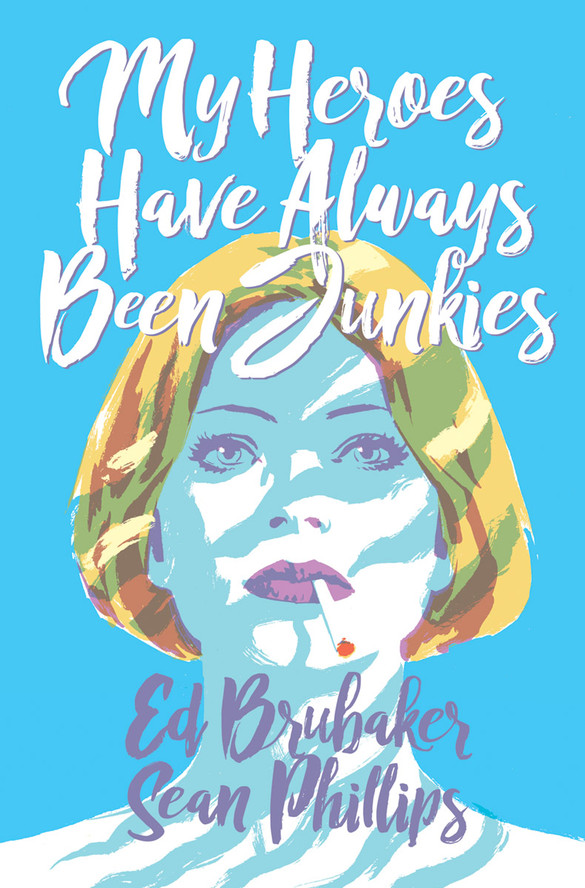
“We did (My Heroes Have Always Been Junkies) a few years ago because Sean had always really wanted to do a European album,” Brubaker said. 4
At the time, Brubaker had been eyeing shorter hardcovers Dark Horse Comics had been releasing that adapted Neil Gaiman prose stories to comic form, like Fábio Moon and Gabriel Bá’s How to Talk to Girls at Parties. It made the writer wonder if a format like that might work for what Phillips had in mind. That setup appealed to the writer for two reasons: it was attractive and they could knock out something of that length in just a few months due to Phillips’ speed. That was how Junkies was born, and like the Criminal Deluxe Editions before it, it was an eye-opening experience.
“That one ended up being a really huge hit,” Brubaker said. “We sold almost the entire print run in the first month it was out, and we printed a lot of them. We printed almost as many of those as we would have of the first issue of a new comic from us.
“And that was a ‘Oh, wow, people really went for this’ moment.”
That was epiphany number two. The third came when Brubaker was on a book tour for that title’s release. As the writer met readers at varying stops, he discovered “a lot of people had only just recently started reading our books,” with Junkies being their very first experience with a Brubaker/Phillips collabo. Not only that, but they were considerably younger than he expected, with lines at each stop dotted with people in their early 20s.
The third realization was that their readers had effectively split into two camps: those who buy their single-issue comics and likely don’t buy the trades or hardcovers – presumably because they’ve already read the comic 5 – and those who exclusively read the deluxe hardcover that’s sure to follow. It was a shift that had slowly started taking hold ever since that first Deluxe Edition, and with Junkies, Brubaker realized it was a capital “T” thing. They weren’t ready to do anything with it yet, though, as the pair was headed into a new volume of Criminal in single issues.
The writer enjoyed their return to that world, but as they got further into that 12-issue stint, Phillips felt an itch to go back to the graphic novella format of Junkies. 6 Brubaker was enjoying himself, but to a degree, the appeal of the original graphic novel format was taking hold. That was at least in part because it was becoming increasingly evident that it was almost the preferred flavor of their partnership amongst readers. Bad Weekend, a hardcover collecting issues #2 and #3 from that Criminal volume, 7 was released to orders that didn’t match their previous effort on Junkies.
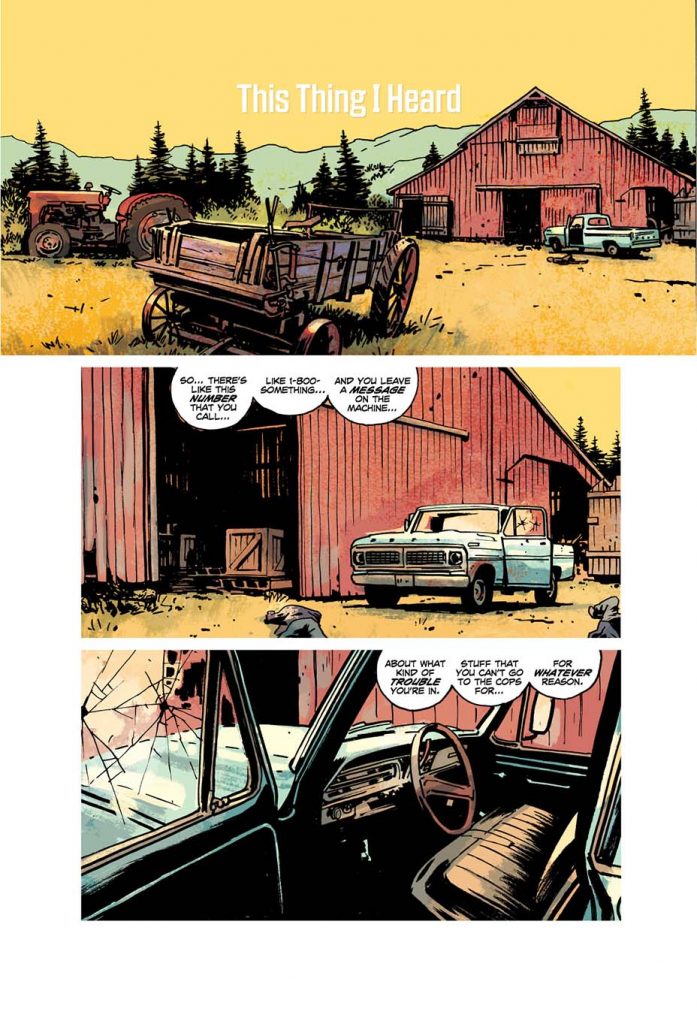
“It felt to me that some of it was about the format. People really like this format,” Brubaker said. “But some of it is the excitement of the new.”
While Bad Weekend still sold better than the single issues – Brubaker told me the Criminal collections sell better than single issues “by far” – it lagged behind Junkies. But even after that revelation, Brubaker still wasn’t thinking of doing a series of graphic novels yet. Two things changed that, and they both start with the letter P.
“(Pulp) 8 was like the first three months of the year for us,” Brubaker told me. “I was loving it, but the whole time I was working on it I wished I had 10 more pages. Not because I would have done anything else in the book probably but just because there was a sense of ‘Oh my god, am I going to have enough room?’”
“And so that was in my head the whole time, and I was thinking someday down the road, we’re going to have to do a longer original graphic novel.”
After Pulp wrapped, Brubaker got to work thinking about their next project, a new monthly book meant to launch around San Diego Comic Con.
“And then the pandemic hit,” the writer sighed.
As Brubaker shared with me, writing is a reflection of the world around you. A way to process whatever is going in your life or brain. He used Pulp as an example. On the surface, it’s about a man’s life in turn of the century Western America and Mexico as well as New York in 1939, but it’s shockingly, frustratingly relevant today. Every bit of it. With the Pandemic in full swing, the writer was in a quandary with their new project because of that process.
“When I sat down with my notebook to start working on the first issue, it just felt not fun,” Brubaker shared. “It’s still an idea I might do at some point, but it was just like everything that was going on in the world. I didn’t want to sit there and have to write this thing I suddenly just wasn’t (excited about).”

Pair that with the uncertainty around the direct market and distribution channels, and you had the perfect recipe for a pop-up existential crisis. Questions of “What do we do?” entered the writer’s brain, and he contemplated all kinds of options, including buying time until their next big effort by publishing short stories on Panel Syndicate, the platform Brubaker and artist Marcos Martin release their digital series Friday on. The way he figured it, if they did that, “when the market reopens we’d have enough stories to put a book of short stories or something.” Anything was on the table.
The pair had also been wrapping up work on Richard Stark’s Parker: The Martini Edition – Last Call, a tribute to Darwyn Cooke that collects The Score and Slayground with bonus materials like a new story from Brubaker and Phillips as well as a roundtable chat about Cooke and Stark’s work with the pair, Bruce Timm and Scott Dunbier. As Brubaker was trying to figure out what was next, he remembered how he was always envious of Cooke just going straight to graphic novels with a story in the vein of his own favorite crime fiction and pulp adventures. It made him think, “God, I wish we could do that,” “just a book starring a character where we come back to see what they get up to next.”
The wheels started turning. It sounded both fun and also pragmatic, especially considering how a) this type of story was incredibly popular in fiction with characters like Jack Reacher and writers like Michael Connelly and b) no one had really ever done this type of story in American graphic novels besides Cooke. He viewed it as “this huge missing thing” in the market. Even more importantly, Brubaker thought with the speed he and particularly Phillips work at, they could both make this type of story happen and release them fast enough to maximize the idea’s effectiveness.
“Instead of going a year between graphic novels or a year between mystery novels or whatever at bookstores, we could get the second book out four months later and we could get the third book out five months after that,” Brubaker said. “Sean and I are fast enough, especially Sean, and we had the lead time because of the pandemic shutdown.”
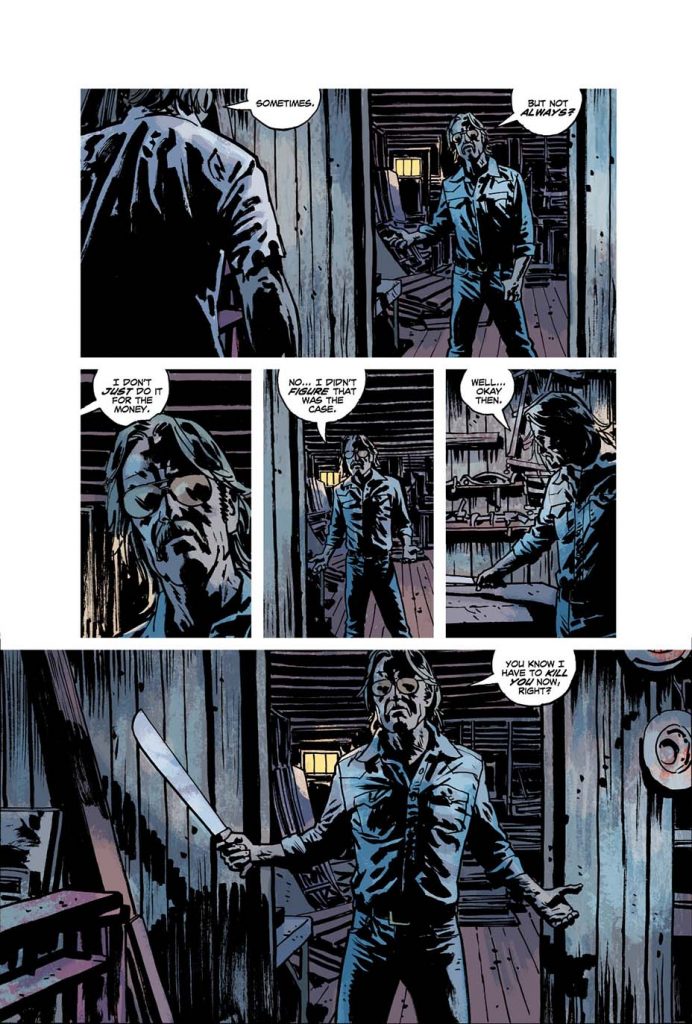
Brubaker started noodling on the idea – both Reckless itself and the series of graphic novels premise it was built upon – but the impact of the pandemic on the market remained. They were moving forward with Reckless, but how they would do it was in question. The pair was even considering going the Kickstarter route with it “until a couple weeks ago” 9 with the performance of Pulp upon its much-delayed release 10 being a bellwether of sorts in determining what they do. Their call was easy once the numbers came in.
“Pulp came out and it was just this huge hit,” Brubaker told me. “Like selling way faster than Junkies, hearing from dozens of stores that are selling over 100 copies on the first day it came out and we’re reordering more. And we printed twice as many as we had orders for.
“I don’t know if we’ll make it through the whole month, at this point, which is just shocking to me.”
So that was it: it was go time with the plan that was recently revealed to the world. And sure, if you look at the announcement on its own, it might seem like a sudden move. But for Reckless and this shift towards publishing original graphic novels to take place, a whole lot of dominoes had to fall in Brubaker and Phillips’ time together. My Heroes Have Always Been Junkies started it. The arrival of the pandemic and the success of Pulp fueled it. And taking on that Parker project focused it. In a way, it did happen quickly. But it was really the product of a whole lot of preceding experiences, and a move that was 11 years in the making.
On the surface, it’s easy to see why Reckless – the comic – would appeal to the pair. It’s about Ethan Reckless, a professional problem solver, someone you call for help if you really need it — but it’ll cost you. Consider it “Dial ‘A’ for Anti-Hero,” but even then you’re not really doing it justice. That’s going around. It’s a common mistake to mislabel the comic already, as many of the early write-ups about the book inaccurately tabbed it as a private eye series 11 when that’s not exactly the case.

“I don’t really consider Reckless to be a PI series even though everyone’s calling it that,” Brubaker admitted. “He’s not really a private eye. He’s more of a troublemaker. I described him as one part Repo Man, one part private eye, and one part wrecking ball.
“He takes jobs and tries to help people.”
That’s a formula that matches the duo well, because their ideal lead is effectively a tough guy with a heart of…well, a tough guy with a heart at the very least. Ethan Reckless is a pantheon-level Brubaker and Phillips creation, with the first half of his upcoming graphic novel 12 revealing him as a character with shocking depth and feel from the start, living in a propulsive story with atmosphere for days. There’s a reason the first book comes armed with pull quotes from luminaries like Patton Oswalt, Damon Lindelof, and Joe Hill: Reckless finds one of comics’ greatest creative pairs at the absolute peak of their powers.
There are many elements that impress, from the clarity of vision they have for Reckless himself and Brubaker’s gift for atmospheric narration to Sean Phillips’ unparalleled storytelling and his son Jacob’s perfectly mood enhancing colors. 13 But the thing that really floors me so far in it is the specificity of the world and character building.
Here’s a quick example: early on in the book, Ethan takes meetings about potential clients with his assistant Anna in the El Ricardo, an old theater he received as payment for a job he previously did for a real estate guy. This scene does two things, both of which it does very well. First, it sets up the plot, putting Ethan on a necessary path. Second, it both helps establish the era in subtle ways while also saying a lot about the characters. Anna is a punk with aspirations, Ethan loves Night of the Hunter 14 and doesn’t like anyone…besides Anna. 15
The scene is loaded with detail, a six-page sequence that sets up everything from the core plot to its key players with wondrous, casual ease. More than that, it evokes a feel without going over the top, something many fail at in era-specific works. Delivering on the feelings connected to this type of story is important to the pair, as its brilliant cover from Phillips shows.
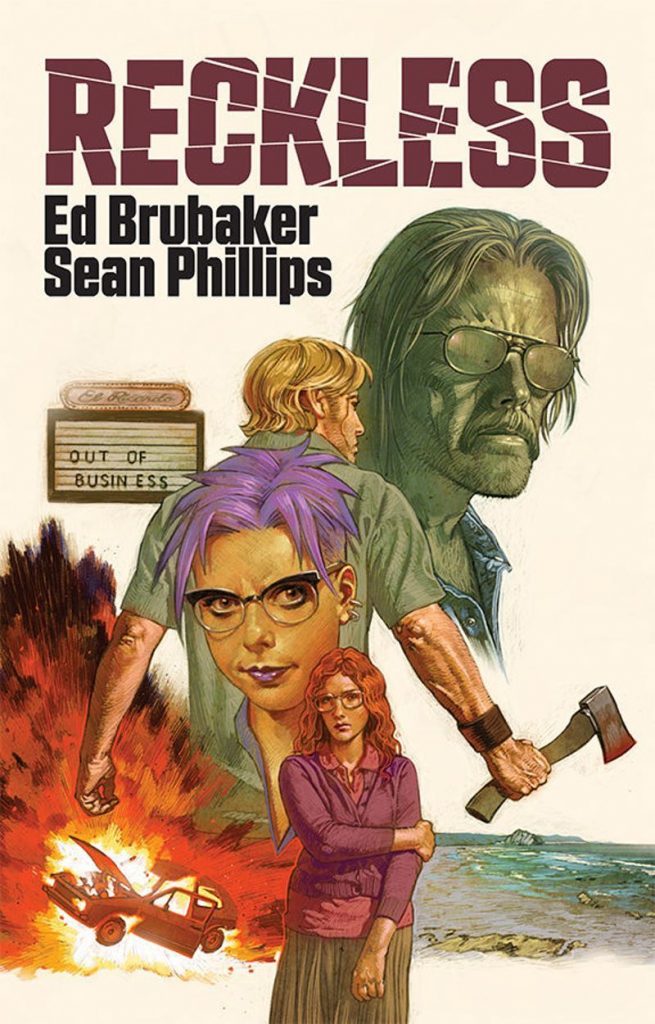
“Look at the cover of Reckless,” Brubaker told me about the nostalgia it evokes. “The cover of Reckless looks like a book from 1975. It literally looks like a book you would’ve seen in a spinner rack as a paperback.” 16
It’s the type of story Brubaker could envision as something people picked up in an airport gift shop or bookstore before a flight, believing it really could be for any type of reader just looking for an entertaining read starring a charismatic lead. 17 And if it sounds like something the team is having fun on, you would be correct in that assumption: Brubaker, for one, is loving it. It’s been the perfect balm for the state of the world.
“I just always have to try to make the book that I want to see. Really that’s where this whole Reckless series comes from. ‘Well, why isn’t anybody doing that? This would be fun to do.’ ‘Hey, I’d like to have fun actually right now because the rest of the world is a fucking nonstop nightmare,’” Brubaker shared. “So maybe my work should be something I get up looking forward to every day because certainly nothing else about the world is.”
That joy combined with the flexibility the length of the book provides has made the experience a fast and free one for the scribe.
“It’s only taken me a few months to write the whole script. I’m just writing this thing straight through,” Brubaker said. “Being able to write through the whole book straight through and not have to be like, ‘Okay, so this chapter is X number of pages,’ and I know that ahead of time. That’s like…I get up every day excited to work on it again.”
It’s also allowing Brubaker to try new things with the story type. Typically with these kinds of books – your Parkers, Travis McGees and Jack Reachers – the stories change but the heroes are static in some ways, most specifically in terms of their age. Brubaker and Phillips flip the script on that idea, using the sequence of books to tell the story of their protagonist throughout his life starting with the first release.
“One of the things I’ve never seen done in one of these series is to have the character age as the years pass. That’s why it starts in the early ’80s,” Brubaker said. “I want to do stories that go all the way into the early 2000s so you can see how living the life of this kind of a person…what it does over time.”
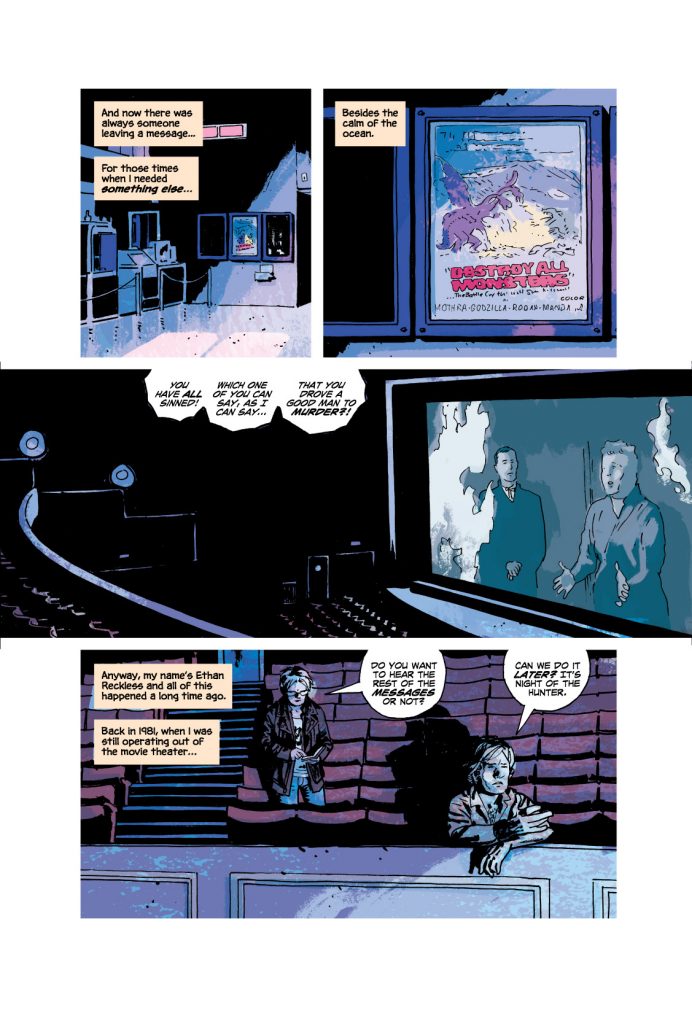
“A lot of times the characters in these books just basically stay the same,” he added, noting that’s not the case for Reckless. “Book One takes place in ’81 & ’82, and Book Two takes place in ’84-’85. I just started mapping it out and I was like, ‘Oh this’ll be fun,’ because then I can comment on the changing culture that I lived through a little bit too.”
The pair is currently set to release a trio of books in the Reckless series over the next year. But be careful how you label that: it’s not a trilogy. Each volume is a completely self-contained story. While you’ll understand the character more if you read all of them, they’re set to be standalone reads that can be read individually or together. That provides flexibility in terms of storytelling, but also in ensuring it finds an audience. It can be difficult for a title to find readers for second or third volumes, as the pair discovered with The Fade Out. 18 But individual books that can be read together or just do their thing? That allows anyone to jump on at any point.
And these will be pristine productions too, seemingly in the vein of Pulp. The pair decided to go the hardcover route after discussing it with Image, retailers and friends in the industry because it does two things. First, these hardcovers sell about as easily as a new #1 from them in their experience. 19 Second, it implies that Reckless isn’t a reprint of a previously existing series, helping readers better understand what they’re getting into. It simplifies the sale, while also leading to higher production value and, if you ask me, a better reading experience. That’s a win for everyone.
There’s more to come too. Five total stories are outlined in addition to the first book, so this could be Brubaker and Phillips’ home for quite some time. Brubaker hopes Reckless achieves a rhythm like their monthly releases, where readers at comic shops and bookstores can expect a new release from him and Phillips at a regular cadence, albeit one that’s a little more elongated. Or they could decide to try something else out after they finish the third story if either of them is feeling an itch to mix things up. 20 That’s the nice thing about Reckless. It gives them enviable amounts of flexibility, and another title to call their home, not unlike what Criminal has been for them in the past.
This move comes at a very strange time for the world of comics. Not only is there this whole pandemic and related economic crisis thing going on, but the broader comic market is facing considerable turmoil, with all of that exacerbated by the bad tidings at DC Comics this week. It’s a time where many creators are considering alternative options. I’ve talked to plenty who are taking long hard looks at crowdfunding and digital or are leering rather lustily at graphic novels and the book market. Shifts are happening already, as some titles have moved to graphic novel releases either for economic or strategic reasons. Comics are changing, or some might say they’ve done so already.
But Brubaker and Phillips making this shift are the ultimate canary in the coal mine to many.
When I shared on my Patreon that I would be speaking with Ed, I heard from several creators who spoke reverentially about the pair’s moves, suggesting what they’re doing is worth studying. When they make a change like this, people pay attention and look to see if there’s something worth learning and, crucially, emulating. It does make me wonder: could Brubaker and Phillips’ move be the first step in what’s next for the American comics market?
Maybe. Maybe not.
But Brubaker does hope that other people in comics pay attention, if only to see if there’s something worth following in their grand experiment.
“In some ways, I hope that this becomes a pattern (where) other people start looking at what we’re doing and do that too,” Brubaker said. “If you’ve gotten to the point where you’ve built up a readership and a reputation and you’re trying to do work that’s intended to be evergreen or bookshelf quality material, and if you can figure out a way to do it as an original graphic novel, it’s just going to be way better for you.”
That’s not to say this is an easy route, or one that’s even adaptable for anyone. Sometimes going big can lead to unforgiving misses, because like Brubaker said, trying to aim for a hit in the book market will leave you “endlessly frustrated because you just never know what’s going to hit there.” 21 It’s better to do what Brubaker and Phillips do and just tell the best versions of your own stories so they can be read by anybody – whether they’re in comic shops or bookstores.
And it’s worth noting that this doesn’t necessarily mean they’re done with single issues. Brubaker loves the format and the ability to add backmatter and extra material for readers. It was important for him to mention that this hardly means they’d never do anything in that vein ever again. But it’s undeniable that the Brubaker and Phillips partnership – one of the finest pairings in comic book history in my mind – is doing something exciting and new with Reckless, and perhaps more importantly, crafting some of the best comics of their respective careers with it.
Will it be the first step in a substantial change for American comics? Who knows. Whatever happens next, though, I know this: we’ll get some great comics out of it.
That’s good enough for me.
Thanks for reading this feature. If you enjoyed it, consider subscribing to SKTCHD for more content like it.
Or at least anti-hero.↩
Gene Gustines.↩
Shouts to Velvet, Brubaker’s excellent series with artist Steve Epting.↩
For those that don’t know, an album is a specific type of release that’s popular in Europe. They’re effectively graphic novellas, but sometimes are longer and often are oversized.↩
Raises hand.↩
Quick note: Junkies and later hardcover releases Bad Weekend and Cruel Summer are all Criminal releases, but none of them have its branding on the covers. It’s only shown inside the book. They did that to ward off the diminishing returns that come with ongoings. So instead of Vol. 7 or whatever, they’re positioned as standalones. Which they are!↩
With additional pages to make it about the length of Junkies.↩
Their recent graphic novella release at Image.↩
The idea would have been using that money to fund the production and then releasing a mass market version through Image.↩
Because of the pandemic.↩
I’ve read the first 60+ pages of the book, with some parts yet to be colored.↩
I was initially uncertain about the younger Phillips on colors when he picked up the gig with Junkies. I quickly realized that’s a “me getting adjusted to a new colorist” thing more than a him thing. He’s doing phenomenal work here.↩
And watches it obsessively.↩
You can find a page from this scene further down the page.↩
Brubaker said it’s the best cover Phillips has ever done, even if it was the second one he made for the comic. It’s hard to disagree with him.↩
Props to Lindelof for his pull quote saying, “Imagine Redford at his peak, ambling through sun-drenched, eighties L.A. in a serpentine plot that is equal parts Long Goodbye and Point Break,” a pitch perfect breakdown of what this book is.↩
Brubaker told me the first volume of that series sold twice as many copies as the second and third volumes.↩
One of the tricks is convincing comic shops to order that way, although Brubaker is hopeful their track record does the work for them.↩
Brubaker told me, “By the time we get to the end of the third one, I’m sure Sean is going to be really mad that he allowed me to commit us to doing three in a row,” so that’s a definite maybe!↩
A quick example: Brubaker was surprised to discover that The Fade Out – an obvious fit for that market – didn’t reach the heights they were hoping for there.↩
